
Master Tax Filing for 2023-24: Simplify & Amplify Your Returns Effortlessly
Tax Filing for 2023-24: The Income Tax Department has activated the electronic lodgement forms, designated as ITR-1, ITR-2, and ITR-4, for the fiscal year spanning 2023 to 2024 (Assessment Year 2024-25) accessible on the e-filing portal. Commencing April 1, 2024, these online submission templates are available for utilization. With these instruments now at their disposal, individuals eligible for submission under these classifications may proceed to declare their fiscal responsibilities for the aforementioned period.
In a preceding move, the tax overseers had unveiled the standalone Excel utilities for ITR-1, ITR-2, and ITR-4. The standalone JSON utilities for ITR-1, ITR-2, ITR-4, and ITR-6, pertinent to the fiscal year 2023-24 (Assessment Year 2024-25), have likewise been disseminated.
The terminal date for the submission of tax declarations for the fiscal year 2023-24 (Assessment Year 2024-25) is fixed for July 31, 2024.
Filing your ITR on time allows you to opt for the old regime, as the new regime is the default option. If you’re looking to file your income tax return seamlessly and efficiently, Techmin Consulting provides a straightforward and reliable service. Begin your tax filing process with us.
Tax Filing for 2023-24: Modalities for tax declaration submission include:
An individual may opt for a purely digital submission via the Income Tax Departments e-filing ledger or a hybrid approach, employing both digital and standalone utilities of JSON and Excel.
For a wholly digital process, an individual may access their account on the e-filing portal and navigate to the ‘File income tax return’ section. Herein, a substantial portion of the individual’s data is auto-populated from their Annual Information Statement (AIS) and Form 26AS. Notwithstanding, it is recommended that one verifies this pre-populated data against their documentation, such as Form 16, Form 16A, among others.
Alternatively, utilizing the standalone utilities of JSON and Excel, downloadable from the e-filing portal, enables individuals to manually input their details. For auto-population in these utilities, downloading pre-filled XML from one’s e-filing account is necessary. Upon completion, these details must be uploaded to the e-filing website.
Eligibility for ITR-1, ITR-2, and ITR-4 is contingent upon one’s sources of income during the fiscal period.
ITR-1 is suitable for resident individuals (excluding those not ordinarily resident) with income from salaries, a singular property, other income sources (e.g., interest, dividends), and agricultural income up to Rs 50,000, with the gross total income not surpassing Rs 50 lakh in a fiscal year. ITR-2 is applicable for those with multiple properties or capital gains. ITR-4 serves individuals with income from business and professions under specific tax sections.
This year, the Central Board of Direct Taxes (CBDT) has advanced the notification of ITR forms, a departure from the usual April announcement. This preemptive measure ensures the availability of both online and standalone utilities at the fiscal year’s inception. However, salaried taxpayers are advised to await the end of June for the requisite TDS certificates before initiating their tax declaration submissions.
Despite the early notification, it’s pivotal for salaried entities to garner their Tax Deducted at Source (TDS) certificates before embarking on their fiscal declarations. This precautionary step ensures that all necessary documentation is in order, facilitating a smoother submission process.
With Techmin Consulting, you can find the LIC policy that best suits your financial goals and provides the security your loved ones deserve. Explore your options with us and ensure your family’s well-being.
Furthermore, the digital and manual submission pathways underscore the tax directorate’s commitment to offering versatile options catering to the individual preferences of taxpayers. Whether opting for the direct, online submission for those comfortable with navigating digital platforms or the more tactile approach of downloading, filling, and uploading forms for those desiring a hands-on method, the system accommodates various taxpayer inclinations.
The unveiling of these forms and utilities signifies a crucial juncture in the fiscal calendar, heralding the commencement of the tax filing season. It underscores the imperative for individuals to assess their financial standings, gathers requisite documents, and fulfil their tax obligations within the stipulated timeline.
Moreover, the diverse array of ITR forms caters to a wide spectrum of fiscal scenarios, from simple salary-based incomes to more complex financial situations involving multiple properties or business revenues. This differentiation ensures that taxpayers find a form that best matches their income structure, thereby simplifying the filing process.
As we navigate through this tax filing season, it’s essential to leverage the resources provided by the tax department, ensuring that all data entered is accurate and reflective of one’s financial transactions throughout the year. The diligence in this preparatory phase not only aids in a hassle-free submission but also aligns with the broader objective of maintaining fiscal discipline and transparency.
In summary, with the activation of the ITR-1, ITR-2, and ITR-4 forms for the fiscal year 2023-24, taxpayers are ushered into a period of fiscal accountability. This moment calls for meticulous preparation, leveraging the available resources to ensure compliance and accuracy in tax filings. As we embark on this annual ritual, it’s a reminder of our collective role in contributing to the nation’s fiscal health, a task that, while daunting, is made manageable through the structures and supports provided by the tax department.
Embarking on the journey of tax filing is not merely a legal obligation but a contribution to the nation’s fiscal health and development. It’s a task that, while appearing formidable, is imbued with the potential to affirm one’s role in the broader societal framework. As taxpayers navigate through the complexities of fiscal declarations, they engage in an act of civic responsibility, contributing their part to the national coffers.
The process, enriched by the digital advancements of the tax department, offers an educational journey into the nuances of financial management and tax planning. For many, it becomes an annual review of financial health, encouraging individuals to scrutinize their earnings, savings, and investments. This introspection not only aids in prudent fiscal planning but also in identifying avenues for tax savings, investments, and ensuring compliance with the law.
Moreover, the diversity in the ITR forms—catering to various income scenarios—highlights the inclusivity of the tax system, accommodating the financial realities of a broad swathe of the population. From the salaried class to entrepreneurs, from freelancers to those with agricultural income, the tax filing system seeks to encapsulate the myriad ways in which individuals contribute to the economy.
As the deadline for tax filing approaches, taxpayers must harness the resources at their disposal. The tax department’s e-filing portal becomes a beacon of guidance, offering step-by-step instructions, pre-filled forms, and a repository of information to demystify the tax filing process. This digital ally simplifies what can often be an overwhelming task, making it accessible even to those who may be embarking on this journey for the first time.
In conclusion, the period of tax filing reflects a dynamic interplay between individual fiscal responsibility and collective societal progress. It’s a time marked by meticulous preparation, adherence to deadlines, and an acute awareness of one’s financial footprint. As taxpayers, the completion of this annual duty is not just about meeting a legal requirement; it’s a reaffirmation of our commitment to societal advancement and the sustenance of public services. Thus, as we move forward in this tax season, let us approach it not with trepidation but with a sense of purpose and responsibility, recognizing our role in shaping the fiscal narrative of our nation.


